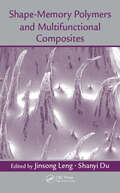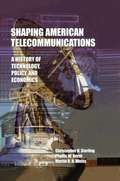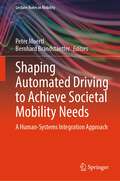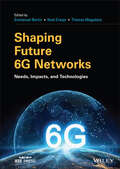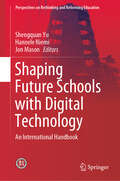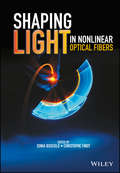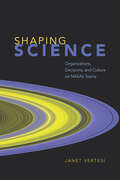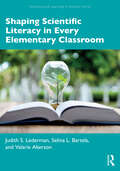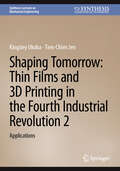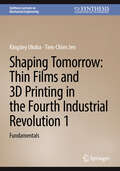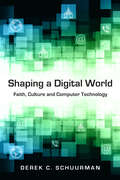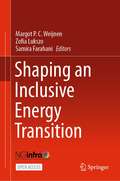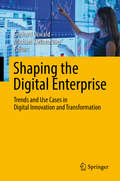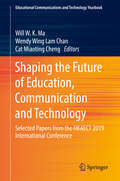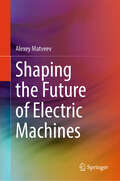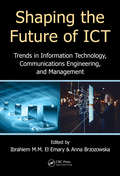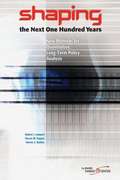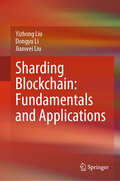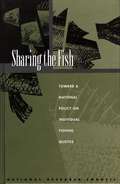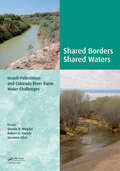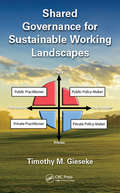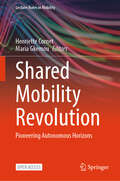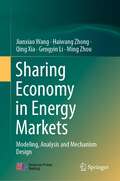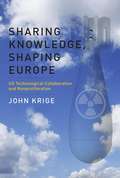- Table View
- List View
Shape-Memory Polymers and Multifunctional Composites
by Shanyi Du Jinsong LengAdmired for their extraordinary stimuli-sensitive behavior and shape-changing capabilities, shape-memory polymers (SMPs) and multifunctional composites are among the most important smart materials. They continue to be widely applied in many diverse fields to create things such as self-deployable spacecraft structures, morphing structures, SMP foams
Shaping American Telecommunications: A History of Technology, Policy, and Economics (LEA Telecommunications Series)
by Christopher H. Sterling Phyllis W. Bernt Martin B.H. WeissShaping American Telecommunications examines the technical, regulatory, and economic forces that have shaped the development of American telecommunications services. This volume is both an introduction to the basic technical, economic, and regulatory principles underlying telecommunications, and a detailed account of major events that have marked development of the sector in the United States. Beginning with the introduction of the telegraph and continuing through to current developments in wireless and online services, authors Christopher H. Sterling, Phyllis W. Bernt, and Martin B.H. Weiss explain each stage of telecommunications development, examining the interplay among technical innovation, policy decisions, and regulatory developments.Offering an integrated treatment of the interplay among technology, policy, and economics as key factors defining the development of the telecommunications sector in the United States, this volume also provides:*background material to facilitate understanding of each sector;*contexts for many so-called "new" issues, problems, and trends, demonstrating origins from years or decades in the past; and*careful annotation, documentation, and reference tables to enable further research on the topics discussed.This unique multidisciplinary approach provides a balanced view of U.S. telecommunications history, in context with relevant economic, legal, social, and technical analyses. As such, it is essential reading for advanced students in telecommunications needing to understand how the telecommunications industry and service developed to its current form. The volume will also serve as a supplemental text in courses on telecommunications regulation, and it will be of value to professionals in the field seeking context and background for their daily work.
Shaping Automated Driving to Achieve Societal Mobility Needs: A Human-Systems Integration Approach (Lecture Notes in Mobility)
by Peter Moertl Bernhard BrandstaetterThis edited book describes novel human-systems integration approaches to improve acceptance, safety, and comfort of automated vehicles. Each chapter analyses different aspects in the development of automated driving systems such as: assessing needs and opportunities of specific user populations i.e. elderly drivers and truck drivers; creating fluid human-systems interactions in the vehicle to answer specific driver needs; developing an automated driving tutoring application; and identifying benefits of including road infrastructure sensors to support automated driving predictability. A detailed description of the assessment of the above-described solutions in real-world situations is also included. Written by both researchers and professionals, this book offers timely and practice-oriented information concerning the development of automated driving systems that better adapt to the users’ needs.
Shaping Future 6G Networks: Needs, Impacts, and Technologies (IEEE Press)
by Emmanuel Bertin Noel Crespi Thomas MagedanzShaping Future 6G Networks Discover the societal and technology drivers contributing to build the next generation of wireless telecommunication networks Shaping Future 6G Networks: Needs, Impacts, and Technologies is a holistic snapshot on the evolution of 5G technologies towards 6G. With contributions from international key players in industry and academia, the book presents the hype versus the realistic capabilities of 6G technologies, and delivers cutting-edge business and technological insights into the future wireless telecommunications landscape. You’ll learn about: Forthcoming demand for post 5G networks, including new requirements coming from small and large businesses, manufacturing, logistics, and automotive industry Societal implications of 6G, including digital sustainability, strategies for increasing energy efficiency, as well as future open networking ecosystems Impacts of integrating non-terrestrial networks to build the 6G architecture Opportunities for emerging THz radio access technologies in future integrated communications, positioning, and sensing capabilities in 6G Design of highly modular and distributed 6G core networks driven by the ongoing RAN-Core integration and the benefits of AI/ML-based control and management Disruptive architectural considerations influenced by the Post-Shannon Theory The insights in Shaping Future 6G Networks will greatly benefit IT engineers and managers focused on the future of networking, as well as undergraduate and graduate engineering students focusing on the design, implementation, and management of mobile networks and applications.
Shaping Future Schools with Digital Technology: An International Handbook (Perspectives on Rethinking and Reforming Education)
by Shengquan Yu Hannele Niemi Jon MasonThis book presents an overview of education technology and its use in schools, with a primary emphasis on best practices of technology enhanced learning; how new technologies such as mobile, augmented and wearable technologies affect instructional design strategies; and the content curriculum development process. Providing insights into the future of education and the upcoming pedagogies that will be applied in schools, it helps educators and other stakeholders make innovations for the new generations of learners in the 21st century.The use of emerging technologies such as mobile and ubiquitous technologies, context-aware technology, augment-reality, and virtual reality is contributing to making education adaptive and smarter. With the ever-changing technologies, how to equip teachers with these digital skills and transform their teaching style is also important to ensure that school education is more individualised and customised for students.Offering a global perspective with integrated practical cases, this timely book is of interest to educators, teachers, and education policymakers. And although most of the authors are from the academia, it provides non-experts with a novel view of what future schools will be like with the help of technology.
Shaping Light in Nonlinear Optical Fibers
by Christophe Finot Sonia BoscoloThis book is a contemporary overview of selected topics in fiber optics. It focuses on the latest research results on light wave manipulation using nonlinear optical fibers, with the aim of capturing some of the most innovative developments on this topic. The book’s scope covers both fundamentals and applications from both theoretical and experimental perspectives, with topics including linear and nonlinear effects, pulse propagation phenomena and pulse shaping, solitons and rogue waves, novel optical fibers, supercontinuum generation, polarization management, optical signal processing, fiber lasers, optical wave turbulence, light propagation in disordered fiber media, and slow and fast light. With contributions from leading-edge scientists in the field of nonlinear photonics and fiber optics, they offer an overview of the latest advances in their own research area. The listing of recent research papers at the end of each chapter is useful for researchers using the book as a reference. As the book addresses fundamental and practical photonics problems, it will also be of interest to, and benefit, broader academic communities, including areas such as nonlinear science, applied mathematics and physics, and optical engineering. It offers the reader a wide and critical overview of the state-of-the-art within this practical – as well as fundamentally important and interesting – area of modern science, providing a useful reference which will encourage further research and advances in the field.
Shaping Science: Organizations, Decisions, and Culture on NASA’s Teams
by Janet VertesiIn Shaping Science, Janet Vertesi draws on a decade of immersive ethnography with NASA’s robotic spacecraft teams to create a comparative account of two great space missions of the early 2000s. Although these missions featured robotic explorers on the frontiers of the solar system bravely investigating new worlds, their commands were issued from millions of miles away by a very human team. By examining the two teams’ formal structures, decision-making techniques, and informal work practices in the day-to-day process of mission planning, Vertesi shows just how deeply entangled a team’s local organizational context is with the knowledge they produce about other worlds. Using extensive, embedded experiences on two NASA spacecraft teams, this is the first book to apply organizational studies of work to the laboratory environment in order to analyze the production of scientific knowledge itself. Engaging and deeply researched, Shaping Science demonstrates the significant influence that the social organization of a scientific team can have on the practices of that team and the results they yield.
Shaping Scientific Literacy in Every Elementary Classroom (Teaching and Learning in Science Series)
by Judith S. Lederman Selina L. Bartels Valarie AkersonThis textbook guides teachers in enacting science instruction that results in the cultivation of scientifically literate students in elementary school. Prompting discussions in the pre-service environment around what it means to be scientifically literate, this book helps teachers introduce children to their world through science and its impact on their daily lives. Chapters show teachers how to design, implement, and assess inquiry-based science instruction through lessons that authentically model real science, investigating questions with multiple solutions, and discussing how these lessons build students’ scientific literacy. Sample lessons are modeled on research and tested practice while also recognizing the need to accommodate a diverse range of students and classroom contexts. Ideal for pre-service science teachers, as well as in-service professional development, this book can be used in any elementary science methods course or wherever state or national standards require developing scientific literacy. In helping teachers produce scientifically literate students, it is a resource that enables students to have the content knowledge, attitudes, and abilities to see the role science plays in issues from the personal to the global.
Shaping Tomorrow: Applications (Synthesis Lectures on Mechanical Engineering)
by Tien-Chien Jen Kingsley UkobaThis two-volume work explores the convergence of thin films and 3D printing within the Fourth Industrial Revolution (4IR), targeting engineers, researchers, students, and professionals. The book begins by elucidating Industry 4.0 and its pivotal drivers, emphasizing the integration of advanced digital technologies, automation, and data-driven insights. Subsequent chapters look into the history, properties, and emerging trends of thin films, showcasing their diverse applications in flexible electronics, green hydrogen production, battery technologies, solar technology, and high-performance displays and lighting. Additionally, it explores the transformative role of 3D printing across industries, from aerospace and automotive to healthcare and consumer goods. The work meticulously addresses challenges and opportunities in adopting these technologies, advocating for collaboration, innovation, and continuous improvement. Lastly, it underscores the integration of thin films and 3D printing, highlighting their synergistic potential in driving innovation, customization, and sustainability in manufacturing and beyond. The work serves as an insightful guide, offering valuable perspectives and insights into the applications and relevance of thin films and 3D printing in the 4IR landscape. This second volume deals with concrete applications.
Shaping Tomorrow: Fundamentals (Synthesis Lectures on Mechanical Engineering)
by Tien-Chien Jen Kingsley UkobaThis two-volume work explores the convergence of thin films and 3D printing within the Fourth Industrial Revolution (4IR), targeting engineers, researchers, students, and professionals. The book begins by elucidating Industry 4.0 and its pivotal drivers, emphasizing the integration of advanced digital technologies, automation, and data-driven insights. Subsequent chapters look into the history, properties, and emerging trends of thin films, showcasing their diverse applications in flexible electronics, green hydrogen production, battery technologies, solar technology, and high-performance displays and lighting. Additionally, it explores the transformative role of 3D printing across industries, from aerospace and automotive to healthcare and consumer goods. The work meticulously addresses challenges and opportunities in adopting these technologies, advocating for collaboration, innovation, and continuous improvement. Lastly, it underscores the integration of thin films and 3D printing, highlighting their synergistic potential in driving innovation, customization, and sustainability in manufacturing and beyond. The work serves as an insightful guide, offering valuable perspectives and insights into the applications and relevance of thin films and 3D printing in the 4IR landscape. This first volume deals with fundamental aspects.
Shaping a Digital World: Faith, Culture and Computer Technology
by Derek C. SchuurmanDigital technology has become a ubiquitous feature of modern life. Our increasingly fast-paced world seems more and more remote from the world narrated in Scripture. But despite its pervasiveness, there remains a dearth of theological reflection about computer technology and what it means to live as a faithful Christian in a digitally-saturated society. In this thoughtful and timely book, Derek Schuurman provides a brief theology of technology, rooted in the Reformed tradition and oriented around the grand themes of creation, fall, redemption and new creation. He combines a concise, accessible style with penetrating cultural and theological analysis. Building on the work of Jacques Ellul, Marshall McLuhan and Neil Postman, and drawing from a wide range of Reformed thinkers, Schuurman situates computer technology within the big picture of the biblical story. Technology is not neutral, but neither is there an exclusively "Christian" form of technological production and use. Instead, Schuurman guides us to see the digital world as part of God?s good creation, fallen yet redeemable according to the law of God. Responsibly used, technology can become an integral part of God?s shalom for the earth.
Shaping an Inclusive Energy Transition
by Zofia Lukszo Margot P. C. Weijnen Samira FarahaniThis open access book makes a case for a socially inclusive energy transition and illustrates how engineering and public policy professionals can contribute to shaping an inclusive energy transition, building on a socio-technical systems engineering approach. Accomplishing a net-zero greenhouse gas emissions economy in 2050 is a daunting challenge. This book explores the challenges of the energy transition from the perspectives of technological innovation, public policy, social values and ethics. It elaborates on two particular gaps in the design of public policy interventions focused on decarbonization of the energy system and discusses how both could be remedied. First, the siloed organization of public administration fails to account for the many interdependencies between the energy sector, the mobility system, digital infrastructure and the built environment. Cross-sector coordination of policies and policy instruments is needed to avoid potentially adverse effects upon society and the economy, which may hamper the energy transition rather than accelerate it. Second, energy and climate policies pay insufficient attention to the social values at stake in the energy transition. In addressing these gaps, this book intends to inspire decision makers engaged in the energy transition to embrace the transition as an opportunity to bring a more inclusive society into being.
Shaping the Digital Enterprise
by Gerhard Oswald Michael KleinemeierThis book sheds light on cross-industry and industry-specific trends in today's digital economy. Prepared by a group of international researchers, experts and practitioners under the auspices of SAP's Digital Thought Leadership & Enablement team within SAP's Business Transformation Services (BTS) unit, the book furthermore presents relevant use cases in digital transformation and innovation. The book argues that breakthrough technologies have matured and hit scale together, enabling five defining trends: hyper-connectivity, supercomputing, cloud computing, a smarter world, and cyber security. It presents in detail how companies are now reimagining their products and services, business models and processes, showcasing how every business today is a digital business. Digitalization, defined as the process of moving to a digital business, is no longer a choice but an imperative for all businesses across all industries and regions. Taking a step toward becoming a digital enterprise is demanding and challenging. The dimensions of customer centricity, leadership and strategy, business models, including offerings (products and services), processes, structure and governance, people and skills, culture, and technology foundation can serve as orientation for digitalization. The articles in this book touch on all dimensions of this digital innovation and transformation framework and offer possible answers to some of the pressing questions that arise when practitioners seek to digitalize their business.
Shaping the Digital Transformation of the Education Ecosystem in Europe: 31st EDEN Annual Conference 2022, Tallinn, Estonia, June 20–22, 2022, Proceedings (Communications in Computer and Information Science #1639)
by Mart Laanpere Terje VäljatagaThis book constitutes refereed proceedings of the 31st Annual Conference on European Distance and E-Learning Network, EDEN 2022, held in Tallinn, Estonia, from June 20–22, 2022. The 11 full papers and 2 short papers presented in this volume were carefully reviewed and selected from a total of 78 submissions. The papers in the volume are organised according to the following topical headings: higher education; teachers’ professional development; digital competencies; inclusive education
Shaping the Future of Education, Communication and Technology: Selected Papers from the HKAECT 2019 International Conference (Educational Communications and Technology Yearbook)
by Will W. K. Ma Wendy Wing Lam Chan Cat Miaoting ChengThis book gathers selected papers from the Hong Kong Association for Educational Communications and Technology 2019 International Conference on the theme of “Shaping the Future of Education, Communication and Technology.” It contributes to a scholarly discussion that looks beyond what future media and technology can offer for education, and reflects on best practices and lessons learned from applying new media and technology in a wide range of fields. Scholars from educational technology, communication, and higher education share their research work in various formats such as empirical research, best-practice case studies, literature reviews, etc. The topics of the papers are divided into four main areas, including curriculum, pedagogy and instructional design; teaching and learning experiences with technology; online learning and open education resources; and communication and media. The book’s unique quality is its combination of perspectives and research work on communication, education and technology. Thus, it will encourage an interdisciplinary discourse and exchange concerning communication, new media, and educational practices.
Shaping the Future of Electric Machines
by Alexey MatveevShaping the Future of Electric Machines is aimed at anyone involved with electric machines, drives, their applications, and related systems. This includes specialists in companies involved in the development or implementation of equipment, as well as students, professors, inventors and philosophers of technology. The content of the book is easy to master and is written in simple language without the use of complex mathematics. Despite its accessibility, the book provides new knowledge and offers a fresh perspective on electromechanics. It enables readers to understand their role in the evolution of electric machines and provides tools for shaping the future. The book also includes numerous examples of innovative solutions in the field of electric machines and drives, which serve as illustrations of various technical problem-solving approaches. Enables readers to understand the evolution of electric machines and offers tools for future design and innovation; Introduces several new concepts that challenge traditional views; Includes examples and illustrations of various technical problem-solving approaches.
Shaping the Future of ICT: Trends in Information Technology, Communications Engineering, and Management
by Ibrahiem M. M. El Emary and Anna BrzozowskaThe International Conference on Communications, Management, and Information Technology (ICCMIT’16) provides a discussion forum for scientists, engineers, educators and students about the latest discoveries and realizations in the foundations, theory, models and applications of systems inspired on nature, using computational intelligence methodologies, as well as in emerging areas related to the three tracks of the conference: Communication Engineering, Knowledge, and Information Technology. The best 25 papers to be included in the book will be carefully reviewed and selected from numerous submissions, then revised and expanded to provide deeper insight into trends shaping future ICT.
Shaping the Next One Hundred Years
by Robert J. LempertA sophisticated reader ought to view with great skepticism the prospect of answering questions about the long-term future. The checkered history of predicting the future-from the famous declarations that humans would never fly to the Limits to Growth study to claims about the "New Economy"-has dissuaded policymakers from considering the effects of their decisions more than a few months or years ahead. However, today's choices will significantly influence the course of the twenty-first century. New analytic methods, enabled by modern computers, may transform our ability to reason systematically about the long term. This report reviews traditional methods of grappling with the morrow, from narratives to scenario analysis, which fail to address the multiplicity of plausible long-term futures. The authors demonstrate a quantitative approach to long-term policy analysis (LTPA). Robust decision methods enable decisionmakers to examine a vast range of plausible futures and design near-term, often adaptive, strategies to be robust across them. Reframing the question "What will the long-term future bring?" as "How can we choose actions today that will be consistent with our long-term interests?" these methods provide powerful analytic support to humans' innate capacity for "what-if-ing." Choosing the challenge of sustainable development as an example, the authors discuss how these methods may be applied to real-world LTPA and a wide range of other challenges of decisionmaking under conditions of deep uncertainty.
Sharding Blockchain: Fundamentals and Applications
by Jianwei Liu Dongyu Li Yizhong LiuThis book presents a novel approach by decoupling the various modules of sharding blockchains and providing detailed insights into the functions and design methodologies of each key module. Previous sharding blockchain solutions suffered from tight coupling between functional modules, making it challenging to achieve optimal security, performance, and scalability. Building upon this foundation, the authors present a universal composable method for composing sharding blockchains in a flexible manner. Additionally, the authors propose a novel shard member configuration method that leverages proof-of-work and verifiable distributed randomness to guarantee that each shard maintains a sufficient proportion of honest nodes, preventing it from falling below the safety threshold. Furthermore, the authors offer a complete design methodology for creating secure and scalable sharding blockchains. This includes reducing the complexity of intra-shard transaction processing through aggregation-supported multi-signature. The authors ensure optimal sharding of computational, communication, and storage resources within a formal security framework. To facilitate flexible cross-shard transaction processing, the authors introduce a new cross-shard Byzantine fault tolerance protocol. Lastly, the authors explore practical applications of sharding blockchains in typical scenarios. In the context of zero-trust cloud-edge-end scenarios, the authors demonstrate how sharding blockchains enable scalable data cross-shard sharing. Simultaneously, the authors design a secure and universally applicable cross-domain device authentication scheme.
Share the Fish: Toward a National Policy on Individual Fishing Quotas
by National Research CouncilMost U.S. fish stocks are fully or over-exploited, and harvesting in many fisheries far exceeds sustainable levels. The individual fishing quota (IFQ) is a relatively new instrument under which harvesting privileges are allocated to individual fishermen--innovative yet controversial for its feared effect on fishing communities and individual fishermen.Based on testimony from fishermen, regulators, environmentalists, and others, Sharing the Fish explores how IFQs might address the serious social, economic, and biologic issues raised by depleted fish stocks. In their approach to a national policy on IFQs, the panel makes direct recommendations to Congress, the Secretary of Commerce, the National Marine Fisheries Service, regional fishery management councils, state authorities, and others.This book provides definitions and examples, reviews legislation and regulations, and includes lessons learned from fisheries on the U.S. East Coast and in Alaska, and in Iceland, New Zealand, and other nations. The committee discusses the public trust doctrine, management of common-pool resources, alternative and complementary approaches to the IFQ, and more.Sharing the Fish provides straightforward answers that will be important to fishery policymakers and regulators, natural resource economists, fishery managers, environmental advocates, and concerned fishermen and their communities.
Shared Borders, Shared Waters: Israeli-Palestinian and Colorado River Basin Water Challenges
by Sharon B. Megdal Robert G. Varady Susanna EdenThis collection of papers examines water management in two of the worlds prominent, arid transboundary areas facing similar challenges. In the Middle East, the chronically water-short Israeli-Palestinian region has recognized the need both to conserve and supplement its traditional water sources. Across the globe on the North American continent, A
Shared Governance for Sustainable Working Landscapes
by Timothy M. GiesekeSustaining our agricultural landscapes is no longer just a technical, scientific or even political problem, but it has evolved into a socially complex, so-called wicked problem of conflicting social governance and economics. This creates an extreme economic obstacle where the value of ecosystem services remains low and diffuse and the transactions costs remain high and multiple.Using Uber-like business platform technology and a shared governance model, a symbiotic demand for environmental benefits is created. Enabling multi-sector transactions for environmental benefits, this platform innovation would remedy the "tragedy of the commons"; the economic nemesis to achieving landscape sustainability. In a nutshell, to sustain our agricultural landscapes a transdisciplinary approach supported by a shared governance model housed within a multi-sided platform in needed. This book introduces an assessment framework identifying governance actors, styles and ratios for socio-ecological systems. The assessment uses a new governance compass to identify the types of actors completing which tasks and identifies the styles of governance used to complete the tasks. It is aimed to anyone involved in sustainability science, agricultural policy planning, or integrated landscape design.
Shared Mobility Revolution: Pioneering Autonomous Horizons (Lecture Notes in Mobility)
by Henriette Cornet Maria GkemouThis open access book gathers contributions to the EU-funded Horizon 2020 project Shared automation Operating models for Worldwide adoption (SHOW). It reports on technologies and business models focusing on supporting the deployment of shared, connected, and electrified automation in urban transport. Chapters discuss practical issues concerning mobility data management, strategies to improve user acceptance and engagement, and reports on assessment and simulation techniques to test shared automated shuttles in various contexts. Overall, this book offers a timely survey on connected and automated mobility, with extensive and practical information for researchers, practitioners, and policymakers, involved in developing user-centred, automated, and sustainable future mobility.
Sharing Economy in Energy Markets: Modeling, Analysis and Mechanism Design
by Ming Zhou Qing Xia Haiwang Zhong Jianxiao Wang Gengyin LiThis book aims to incorporate an emerging successful business model, i.e., sharing economy, into energy markets, thus digging out the potential merits and applications in multi-energy sectors. With the core idea “access over ownership”, sharing economy enables the collaborative consumption of idle resources through advanced information and communications technology. One critical challenge is to identify different market participants’ occupation while accordingly designing pricing mechanisms. This book begins with an overview about the recent development of sharing economy in energy fields, and summarizes two energy market-related issues that sharing economy can hopefully address. One is how to quantify a marginal generator’s contribution and thereby elicit truthful bidding under information asymmetry condition. The other is how to distinguish renewable and distributed energy resources’ contribution and thus incentivize efficient aggregation considering increasing scale and uncertainty. Then sharing economy mechanisms are proposed and designed from a game theory perspective. On this basis, the following chapters thoroughly investigate the specific problems in spot markets, multi-area markets, renewable energy aggregation and energy systems integration. Additionally, the benefits brought by sharing economy are evaluated in terms of regional market bidding and transmission expansion deferral. Finally, the information and communications technologies related to sharing economy are modeled and analyzed. Hopefully, this book can greatly benefit the readers who are interested in energy economics and engineering.
Sharing Knowledge, Shaping Europe: US Technological Collaboration and Nonproliferation
by John KrigeIn the 1950s and the 1960s, U.S. administrations were determined to prevent Western European countries from developing independent national nuclear weapons programs. To do so, the United States attempted to use its technological pre-eminence as a tool of "soft power" to steer Western European technological choices toward the peaceful uses of the atom and of space, encouraging options that fostered collaboration, promoted nonproliferation, and defused challenges to U.S. technological superiority. In Sharing Knowledge, Shaping Europe, John Krige describes these efforts and the varying degrees of success they achieved. Krige explains that the pursuit of scientific and technological leadership, galvanized by America's Cold War competition with the Soviet Union, was also used for techno-political collaboration with major allies. He examines a series of multinational arrangements involving shared technological platforms and aimed at curbing nuclear proliferation, and he describes the roles of the Department of State, the Atomic Energy Commission, and NASA. To their dismay, these agencies discovered that the use of technology as an instrument of soft power was seriously circumscribed, by internal divisions within successive administrations and by external opposition from European countries. It was successful, Krige argues, only when technological leadership was embedded in a web of supportive "harder" power structures.
